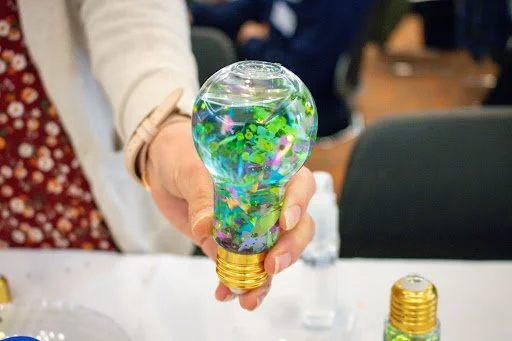Winter Wonderland Science
How are snowflakes formed?
You may have guessed it, but snow is simply just frozen water! What makes snow interesting is the way each individual snowflake is made. Water vapor is lighter than atmospheric air so it rises high in the sky, making clouds. As the vapors travel up, the temperature gets colder, and the air can’t hold onto as much water vapor. This creates a supersaturated state, where the air can’t hold onto the water vapor very well and the vapor condenses on the dust particles in the air. If it is cold enough, these little particles form snow crystals. When the snow gets too heavy for the air to keep it up in the sky, these ice crystals fall to the earth in all sorts of shapes and sizes. Often hundreds or even thousands of individual snow crystals stick together while falling, forming big puff-balls we commonly call snowflakes.
Each snow crystal has six-fold symmetry, creating a hexagonal structure like honeycombs and pencils. Snow crystals start out as a hexagonal plate that then grows out from the corners, creating a unique structure as it grows. Each crystal tumbles through different environments, causing the arms to grow just a little bit differently each time. All six arms grow out of the same environment, so they hold onto the symmetrical shape as they slowly build out. No two snowflakes look exactly alike since they all take different journeys through the clouds during their creation.
Chart of different crystal structures
Each snow crystal starts out as a hexagonal structure, but only certain temperature and humidity creates the iconic “dendrite” snowflakes we commonly attribute to the shape of snowflakes. As per the figure, if the cloud temperature is between ~13-25°F, the hexagon grows longer creating needles and prisms, rather than growing outward. Each snow crystal forms slightly different than its neighboring crystals because its local environment is not quite the same. With each slight change in temperature, there is a change in how much water the cloud in the spot can hold on to i.e. its relative humidity in that spot. Each snow crystal takes a different path through the cloud as it forms, creating a different local environment around the structure as it forms. Exactly why snow crystals grow like this is still being studied
How do we get different colors of snow?
The color we see is the color reflected from a surface
Source: https://justledus.com/photoreceptors-and-spectral-absorption/
We tend to think of clean snow as appearing white. This is because visible light from the sun is white and it reflects off the surface fairly uniformly, so no one color slicks out in short distances. Red light is slightly more absorbed (soaked up) than blue light, which is why at greater distances, snow can appear blueish from some red light being absorbed. For instance, the thicker the snow, the less color reaches the bottom layers, making the lower (i.e. further away) snow to look slightly blue.
Particles and organisms in the snow can also affect the color. There are cold-loving algae that contains a bright red pigment that turns the surrounding snow pink. Even though this type of snow is named “Watermelon snow”, it is not a good idea to eat it. Blood Falls in Antarctica also creates deep red snow, but for a whole different reason. Saltwater rich in iron leaks out from under the glacier. When the iron reacts with the air, it turns red giving it its name of Blood Falls.
“Watermelon snow” in a mountain
Source: https://nsidc.org/cryosphere/snow/science/characteristics.html
How do Inuits survive in igloos in the harsh winters?
In the harsh tundra of the north, Inuits build igloos to survive the cold and wind. Even though snow is pretty cold, interesting properties of snow warm the inside of the shelter. Igloos need to be made out of very tightly packed snow to withstand construction. Normally people think of igloos as a small dome with a tunnel leading out. This is common for small hunting and fishing shelters, but a skilled builder can create a small igloo village by making hallways to each room.
An igloo village
Source: https://www.canadiangeographic.ca/article/map-curator-examines-history-arctic-exploration
Hypothetically, if the igloo is constructed well, it could raise the temperature up to 40 degrees using just a small oil lamp and body heat. The walls protect the inhabitants from harsh winds that make the freezing temperatures even worse. The packed snow and ice act as an insulator, trapping the heat inside rather than letting it escape, creating a feedback loop of heat for the inhabitants. An igloo’s ability to insulate actually increases after a couple days of use. The igloo starts to melt a little over time due to the sun, body heat, and lamps. When the igloo is empty, it cools down so the melted snow freezes over again, making a layer of ice. This makes the igloo even stronger and warmer!
References:
Hoyt, A. (2008, January 17). How igloos work. HowStuffWorks. Retrieved January 5, 2022, from https://people.howstuffworks.com/igloo.htm
Kanchwala, H. (2021, November 13). How does snowfall occur? Science ABC. Retrieved January 2, 2022, from https://www.scienceabc.com/nature/why-does-snowfall-occur.html
Libbrecht, K. G. (n.d.). Guide to snowflakes. snowcrystals.com. Retrieved January 2, 2022, from http://www.snowcrystals.com/guide/guide.html
Libbrecht, K. G. (n.d.). Snowflake science. snowcrystals.com. Retrieved January 2, 2022, from http://www.snowcrystals.com/science/science.html
National Snow and Ice Data Center. Snow Characteristics | National Snow and Ice Data Center. (2020, January 10). Retrieved January 5, 2022, from https://nsidc.org/cryosphere/snow/science/characteristics.html




































